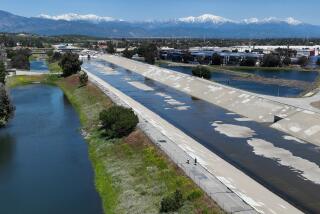Op-Ed: The best place for California’s water is underground

Here’s a suggestion for decision-makers on the California Water Commission who are now finalizing the distribution of $7.5 billion in bond money for storage projects: Look underground.
The state should give up — at last — on dated, expensive, environmentally destructive dams and instead put funds toward infrastructure and programs that would help us store more water in aquifers, where there’s plenty of room.
In fact, the vacant storage space in California’s aquifers is about three times as large as the volume of all of the state’s surface reservoirs, according to Ellen Hanak, water specialist at the Public Policy Institute of California.
Aquifer storage has been used in California for decades, but it has gotten increased attention since the state passed the Sustainable Groundwater Management Act of 2014. That law requires water districts to begin regulating groundwater use. It was inspired, in part, by the understanding that California’s other water storage methods — dams and Sierra snowpack— have declined. No large, river-obstructing dams have been built in California since the 1970s (partly because all the best sites are already taken), and the snowpack is dwindling as a result of climate change.
The simplest way to recharge aquifers is to flood the ground over them.
Aquifers offer more resilience than either alternative. They are often located precisely beneath the communities that consume their water, so they reduce pumping costs and promote local control. Recharging them is relatively cheap. And unlike reservoirs, aquifers aren’t subject to evaporation. By contrast, the nation’s two biggest reservoirs, Lakes Mead and Powell, annually lose about 10% of all the water flowing through the Colorado River basin, according to Ben Livneh, a hydrologist at University of Colorado at Boulder.
Aquifer storage holds particular promise for the southern San Joaquin Valley, where agricultural groundwater use is unsustainably high. Since the mid-1980s, valley farmers have annually pumped an average of 1.8 million more acre-feet of groundwater than is replaced by natural and intended replenishment. So much pumping has occurred, in fact, that in some places, aquifers have compacted and the land above them has subsided by as much as 28 feet. The threat of compaction lends urgency to recharging the aquifers: Leave large portions of them empty for extended periods and many more will contract, losing their storage capacity forever.
The advantages of recharging are sizable. According to Hanak, it’s possible to refill the aquifers at a rate that would make up for the extraction of between 500,000 and 1 million acre-feet of water per year, enough to eliminate between a quarter and a half of the valley’s overdraft problem.
The simplest way to recharge aquifers is to flood the ground over them, as happened naturally before industrial agriculture and dammed rivers upended the valley’s water regime. An emerging replenishment technique, “on-farm recharge,” mimics that process in a controlled way: During wet seasons when precipitation is exceptionally high, some of the high flows from reservoirs into aqueducts and canals can be diverted to designated farms where land is fallow or crops can withstand flooding.
To demonstrate the concept, Sustainable Conservation, a San Francisco-based nonprofit, has tracked 200 San Joaquin Valley farmers who agreed to allow flooding on their land in return for water delivered at reduced cost. Even without additional investment in expanding the canals’ capacity (a significant impediment now), studies suggest the technique could offset 25% or more of the region’s annual groundwater overdraft.
Aquifers can play just as vital a role in cities as in farm country. Since the mid-1970s, the Orange County Water District has been the world’s leader in treating urban users’ wastewater, storing it in an aquifer, then distributing it as drinking water. By the time the district completes an expansion in 2023, the system will convert enough wastewater to drinking water to serve about a million of its 2.5 million customers.
Enter the Fray: First takes on the news of the minute from L.A. Times Opinion »
Los Angeles’ San Fernando Basin aquifer is considered a “critical” part of the city’s water future, as William VanWagoner, an assistant division director at the city’s Department of Water and Power, told me. Groundwater, mostly from the San Fernando aquifer, usually comprises around 11% of the city’s water supply, but that amount could double if the aquifer were fully used. Unfortunately, it’s contaminated with industrial fluids. The DWP plans to clean it but the city won’t be able to draw potable water from all of it for at least a couple of decades.
Even so, an expanded role for aquifer recharge throughout the state is nearly inevitable, among other reasons because of its low cost. According to Sustainable Conservation’s calculations, the cost of water collected via on-farm recharge is $63-$168 per acre-foot over a 100-year period; the cost of water collected by the proposed Temperance Flat reservoir, on the San Joaquin River above the San Joaquin Valley, is $1,900 per acre-foot over the same period.
To help expand aquifer storage, the California Water Resources Control Board should establish a simple process for determining when a wet season is bountiful enough to allow diversions for recharge. And the capacity of the canals and aqueducts that feed water to fields for on-farm recharging should be expanded to take advantage of high water seasons. That investment would be far more cost-efficient than building another dam.
Jacques Leslie is a contributing writer to Opinion.
Follow the Opinion section on Twitter @latimesopinionand Facebook
More to Read
A cure for the common opinion
Get thought-provoking perspectives with our weekly newsletter.
You may occasionally receive promotional content from the Los Angeles Times.






